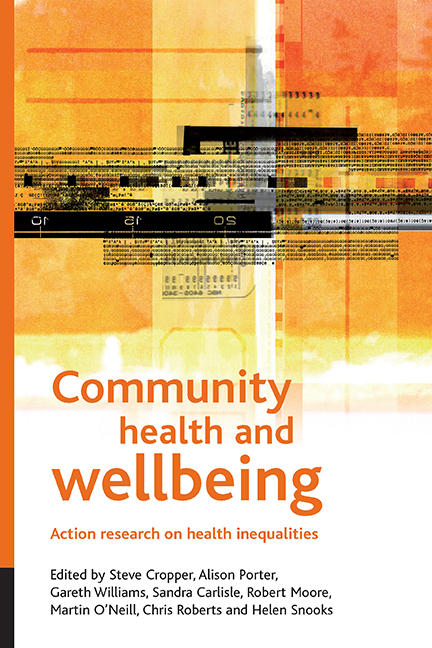Book contents
- Frontmatter
- Contents
- List of tables and figures
- Preface
- Acknowledgements
- Notes on contributors
- one Health inequalities in their place
- two ‘Policy experiments’: policy making, implementation and learning
- three Policy innovation to tackle health inequalities
- four Action research partnerships: contributing to evidence and intelligent change
- five Engaging with communities
- six The role of the community-based action researcher
- seven Evaluation, evidence and learning in community-based action research
- eight Social theory, social policy and sustainable communities
- nine Beyond the experimenting society
- Index
- SHARP DVD: A Way of Working Together to Improve Our Lives
five - Engaging with communities
Published online by Cambridge University Press: 15 September 2022
- Frontmatter
- Contents
- List of tables and figures
- Preface
- Acknowledgements
- Notes on contributors
- one Health inequalities in their place
- two ‘Policy experiments’: policy making, implementation and learning
- three Policy innovation to tackle health inequalities
- four Action research partnerships: contributing to evidence and intelligent change
- five Engaging with communities
- six The role of the community-based action researcher
- seven Evaluation, evidence and learning in community-based action research
- eight Social theory, social policy and sustainable communities
- nine Beyond the experimenting society
- Index
- SHARP DVD: A Way of Working Together to Improve Our Lives
Summary
Introduction
This chapter sets out learning from the Sustainable Health Action Research Programme (SHARP) about the character of communities, strategies for the development of relationships with communities, and the difficulties encountered in those relationships. It also considers the outcomes – more and less tangible – that may survive as meaningful resources for continuing community–agency relations. We consider community engagement as a continuing process, and one in which initial engagement and re-engagement offer particular challenges to both communities and to the SHARP partnerships.
Engagement of the SHARP projects with the communities within which they were working has been a fundamental criterion of their success. There are two reasons for this. First, the projects needed to engage with communities in order to give themselves academic credibility: it is no good basing a project on what communities perceive as their own health needs if you cannot demonstrate that community members themselves have defined and articulated those needs. Second, by its very nature, action research is based on engagement and cannot function without it. Engagement with communities is necessary both to identify needs but also to convert understandings of needs into interventions, resources and practices that may bring about change.
The terms ‘engagement’, ‘involvement’ and ‘participation’ are all used to discuss the processes by which organisations and their users, or the broader community, can work together on the planning, design, delivery and monitoring of services. These processes are seen as essential to ensuring that public services are appropriate in nature and delivered in an appropriate way; and community involvement, community strategies and community leadership have become key building blocks of New Labour's approach to public policy and public service delivery. The Health Development Agency (HDA) has defined the ‘new’ public health agenda as focusing on community-based frameworks to affect the underlying determinants of health inequalities (Rogers and Robinson, 2004), while the Department of Health has commissioned the Nuffield Institute for Health to produce a series of guides to community involvement for providers of health and social care in England (Emmel, 2004; Emmel and Conn, 2004).
- Type
- Chapter
- Information
- Community Health and WellbeingAction Research on Health Inequalities, pp. 105 - 128Publisher: Bristol University PressPrint publication year: 2007

